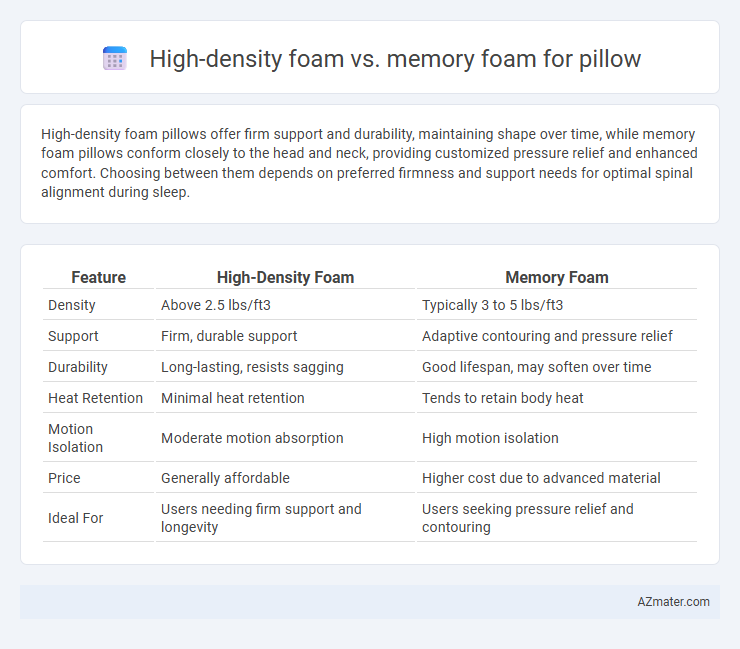High-density foam pillows offer firm support and durability, maintaining shape over time, while memory foam pillows conform closely to the head and neck, providing customized pressure relief and enhanced comfort. Choosing between them depends on preferred firmness and support needs for optimal spinal alignment during sleep.
Table of Comparison
| Feature | High-Density Foam | Memory Foam |
|---|---|---|
| Density | Above 2.5 lbs/ft3 | Typically 3 to 5 lbs/ft3 |
| Support | Firm, durable support | Adaptive contouring and pressure relief |
| Durability | Long-lasting, resists sagging | Good lifespan, may soften over time |
| Heat Retention | Minimal heat retention | Tends to retain body heat |
| Motion Isolation | Moderate motion absorption | High motion isolation |
| Price | Generally affordable | Higher cost due to advanced material |
| Ideal For | Users needing firm support and longevity | Users seeking pressure relief and contouring |
Introduction to High-Density Foam and Memory Foam Pillows
High-density foam pillows offer firm support by maintaining their shape and providing consistent pressure relief, making them ideal for sleepers seeking durability and spinal alignment. Memory foam pillows conform closely to the contours of the head and neck, utilizing viscoelastic properties to enhance comfort and reduce pressure points. Both materials excel in providing ergonomic support, but their differences in density and responsiveness cater to varying sleep preferences and support needs.
Composition and Material Differences
High-density foam pillows are made from polyurethane with a firm, supportive structure that retains shape and offers consistent support, ideal for spinal alignment. Memory foam pillows consist of viscoelastic polyurethane foam designed to contour to the head and neck by responding to body heat and pressure, providing personalized cushioning. The key composition difference lies in the memory foam's ability to mold dynamically, while high-density foam maintains a more rigid, uniform firmness.
Support and Comfort Comparison
High-density foam pillows provide firm support by maintaining shape and offering consistent pressure distribution, making them ideal for individuals needing strong neck alignment. Memory foam pillows contour to the head and neck, enhancing comfort by reducing pressure points and adapting to body heat for personalized cushioning. Both materials deliver unique benefits; high-density foam excels in durability and support, while memory foam excels in conforming comfort and pressure relief.
Pressure Relief Capabilities
High-density foam pillows provide firm support by maintaining shape under pressure, effectively reducing neck and shoulder strain for side and back sleepers. Memory foam excels in contouring to the unique curves of the head and neck, offering superior pressure relief by evenly distributing weight and minimizing pressure points. Both types enhance spinal alignment, but memory foam's viscoelastic properties typically deliver more personalized comfort in pressure relief.
Durability and Longevity
High-density foam pillows offer superior durability due to their robust cellular structure, maintaining shape and support for several years without significant sagging. Memory foam pillows, while providing excellent contouring and pressure relief, tend to soften and degrade faster under everyday use, generally lasting around 2 to 3 years. For long-term investment, high-density foam ensures longer-lasting resilience and consistent comfort compared to memory foam alternatives.
Temperature Regulation and Breathability
High-density foam pillows offer superior support but tend to retain heat due to their dense structure, resulting in less effective temperature regulation compared to memory foam. Memory foam is engineered with viscoelastic properties that conform to body shape and often incorporate cooling gel or open-cell technology to enhance breathability and dissipate heat. Choosing between high-density foam and memory foam pillows depends on the balance between support preferences and the need for improved airflow and temperature control during sleep.
Allergen Resistance and Health Benefits
High-density foam pillows offer superior allergen resistance due to their dense structure, which inhibits dust mites and mold growth, making them ideal for allergy sufferers. Memory foam also provides good allergen protection and conforms to the shape of the head and neck, promoting spinal alignment and reducing pressure points for better sleep quality. Choosing either foam can enhance respiratory health by minimizing exposure to common allergens and supporting proper neck posture during sleep.
Price Differences and Value
High-density foam pillows typically cost less than memory foam pillows, offering a budget-friendly option without sacrificing support and durability. Memory foam pillows, although priced higher due to advanced viscoelastic properties, provide superior contouring and pressure relief, enhancing sleep quality. Evaluating price differences alongside benefits reveals that high-density foam offers great value for cost-conscious consumers, while memory foam justifies its premium with added comfort and ergonomic support.
Suitability for Different Sleep Positions
High-density foam pillows provide firm support ideal for back and stomach sleepers by maintaining spinal alignment and preventing neck strain. Memory foam pillows contour closely to the head and neck, offering pressure relief especially beneficial for side sleepers who need extra cushioning for shoulder alignment. Choosing between high-density foam and memory foam depends on individual sleep positions and preferred firmness to ensure optimal comfort and support throughout the night.
Choosing the Right Foam Pillow for Your Needs
High-density foam pillows provide firm support and durability, ideal for those who prefer a solid, resilient feel that maintains shape over time. Memory foam pillows contour to the head and neck, offering pressure relief and optimal alignment, making them suitable for side or back sleepers experiencing joint pain. Selecting the right foam pillow depends on personal comfort preferences, sleep position, and any specific support requirements such as neck or shoulder pain.

Infographic: High-density foam vs Memory foam for Pillow
 azmater.com
azmater.com